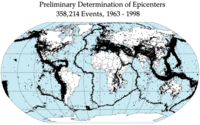
Photo from wikipedia
We propose a single-station approach to estimate near-surface elastic structure using collocated pressure and seismic instruments. Our main result in this study is near-surface rigidity (shear modulus) structure at 784… Click to show full abstract
We propose a single-station approach to estimate near-surface elastic structure using collocated pressure and seismic instruments. Our main result in this study is near-surface rigidity (shear modulus) structure at 784 EarthScope Transportable Array (TA) stations in operation from mid-2011 to the end of 2018 using coherent horizontal seismic and pressure signals at 0.02 Hz. We isolate time periods for which surface pressure change is the dominant excitation source for seismic signals by searching for data windows with large pressure variations and high-seismic-pressure coherence. We emphasize the importance of using horizontal seismic components for two reasons: first, horizontal seismic signals are significantly higher than vertical signals at 0.02 Hz due to ground tilt, and second, we can analytically compute the predicted horizontal signals without an assumption of atmospheric pressure wavespeed (which is required for predicting the vertical excitation). Sensitivity kernels from 0.01 to 0.05 Hz show that this pressure–seismic coupling is mostly dependent on rigidity shallower than 50 or 100 m. Our estimates of shallow elastic structure show good spatial agreement with large-scale surface geological features. For instance, stations in the Appalachian Mountains mostly have high rigidity, whereas low-rigidity sites dominate the Mississippi Alluvial Plain. Because of the lack of measured velocity profiles, we quantitatively validate our approach by comparing with VS30 models that are based on proxies such as topographic slopes and large-scale surface geology. We estimate near-surface rigidity at 784 TA stations, where these locations have no prior structure information. Our method provides independent information for seismic hazard studies.
Journal Title: Bulletin of the Seismological Society of America
Year Published: 2020
Link to full text (if available)
Share on Social Media: Sign Up to like & get
recommendations!